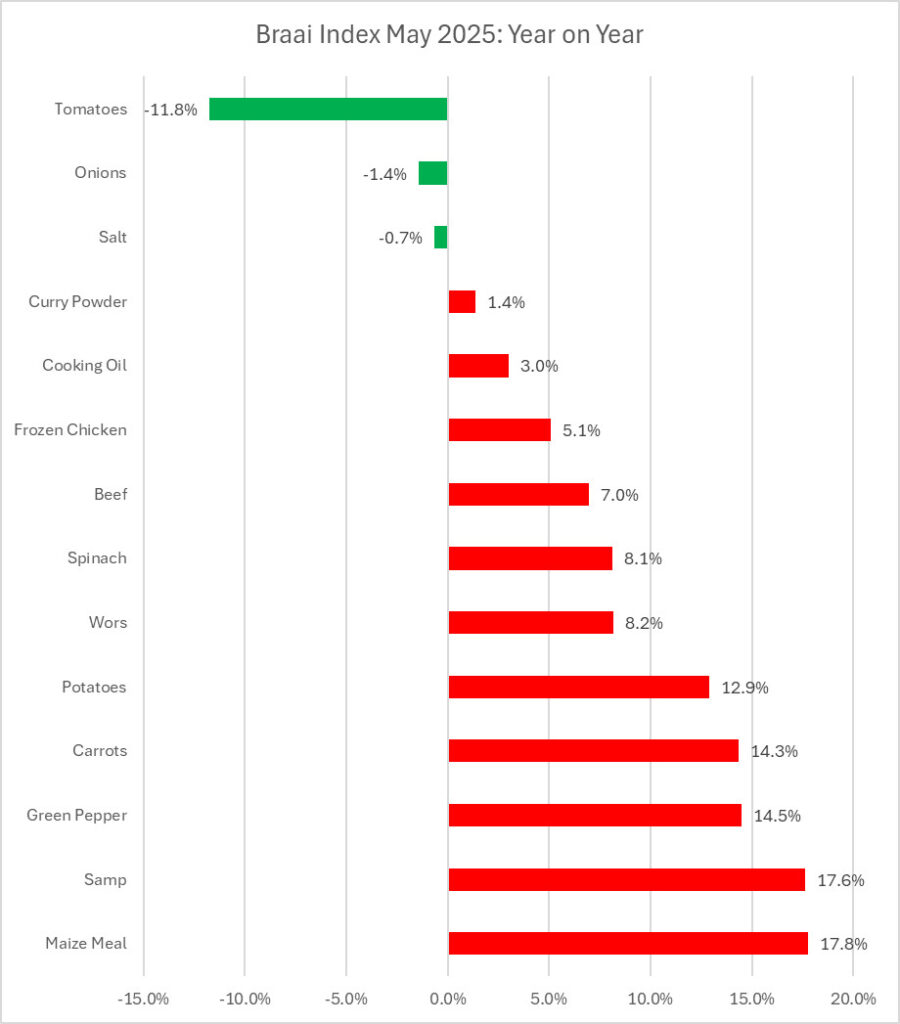Pain for braai lovers in South Africa

South Africans looking to beat the winter chill by lighting up a braai are in for some pain, with the latest Braai Index showing above-inflation price hikes hitting hard.
The index shows that prices have increased by an inflation-busting 6.9% year on year, far above headline inflation at 2.8% in April. Month on month, the basket has also increased by 2.4%.
This follows increases to both indices of about 4% in April.
The Braai Index, originally developed by Bloomberg, is compiled monthly using pricing data from the Pietermaritzburg Equity Justice and Dignity (PMBEJD) group.
It tracks the prices of a selection of essential items typically used for a South African braai, offering a focused view of inflation at the grill.
This includes meat (beef, wors, chicken portions), vegetables (spinach, carrots, tomatoes, potatoes, onions, green pepper) and others (samp, maize, curry powder, salt).
Looking at the month-on-month index, only three items came down in price, with tomatoes (-9%), green peppers (-1.7%) and cooking oil (-0.7%) providing some relief.
However, all other items saw increases, with onions shooting up over 22%. Notably, however, onions are cheaper than they were a year ago.
Tomatoes are also almost 12% cheaper than they were in May 2024, while salt (-0.7%) was the only other item to come down in price over the past 12 months.
The overall trend in the index reflects rising food prices as tracked by Stats SA as well.
In April 2025, headline inflation was recorded at 2.8% year-on-year, sitting outside the Reserve Bank’s target range of 3% to 6%.
However, food and non-alcoholic beverage inflation rose to 4.0% (in line with April’s Braai Index). This means CPI in May is likely to track higher, with food prices again pushing above the headline amount.
Month-on-month index change [+2.4%]

Year-on-year index change [+6.9%]

Bad news for meat prices in South Africa
An especially tough pill to swallow for braai lovers is that meat prices in South Africa are coming under pressure, with Stats SA recording significant inflation for many varieties.
Between March and April, beef products in particular have seen sharp increases, with lamb and pork also going up.
Meat is the largest weighted group in the Food NAB category and accounts for 5.1% of total household spending. It is also arguably the most important part of a braai.
While chicken inflation has been muted, producers have warned that prices could shoot up in the coming months following a ban on imports from South America.
Meat producer Eskort warned on Tuesday (27 May) that a ban on chicken imports from Brazil amid an avian flu outbreak would wreak havoc on local supplies.
While local poultry producers have assured that they have the capacity to make up the chicken shortfall, this is only true for fresh and frozen chicken, not for mechanically deboned chicken meat.
Mechanically deboned chicken meat from Brazil is used by Eskort and its competitors to make Polony, Viennas, Russians and Braaiwors.
South Africa imports about 19,000 tonnes of mechanically deboned chicken from Brazil every month, accounting for 92% of the industry’s needs.
The Association of Meat Importers and Exporters (AMIE) warned of serious economic and food insecurity consequences for South Africa as a result of the ban.
The group said that processed meat producers are facing cost surges as inventory levels are thinning, and shelf prices are starting to reflect this reality, with prices already surging from R13 to R31/kg.
Consumers can expect this to continue for as long as the shortages last.





















